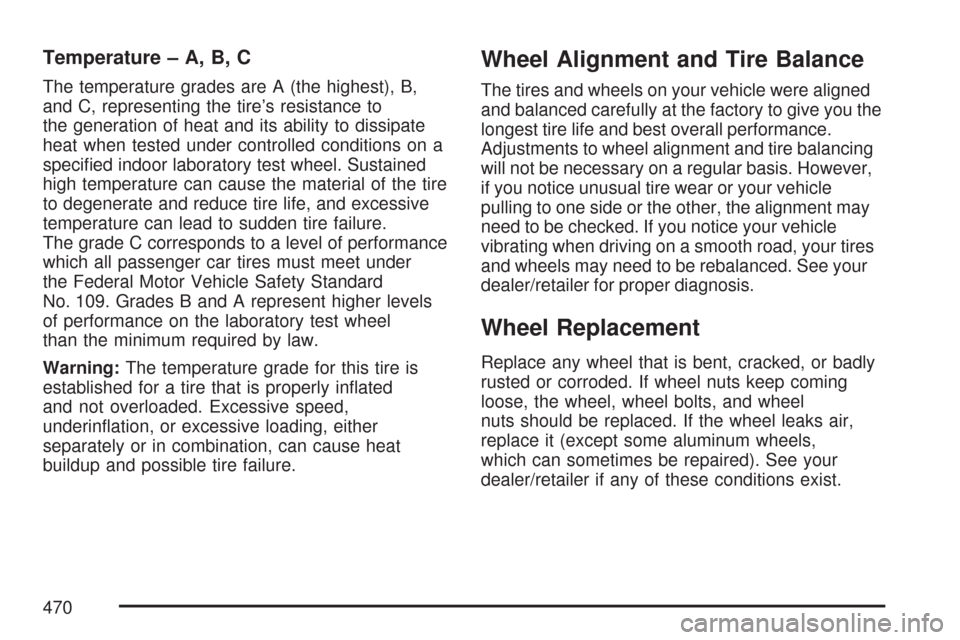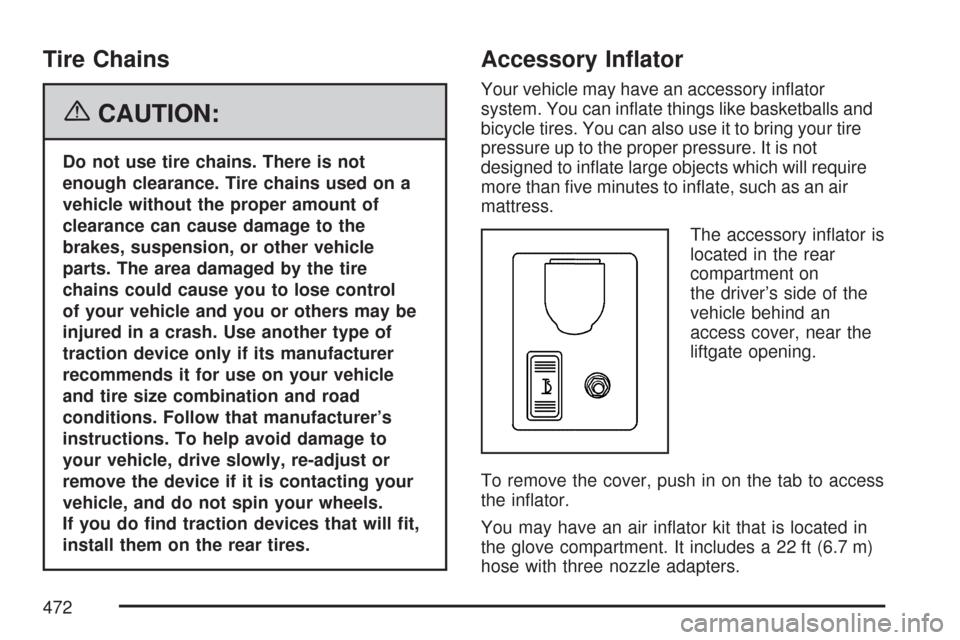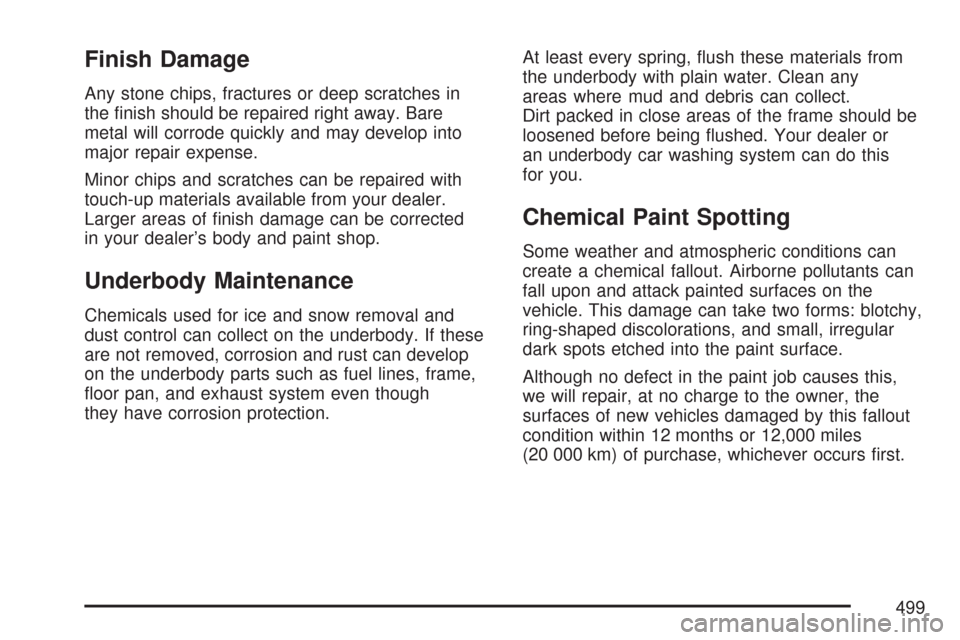Page 470 of 574

Temperature – A, B, C
The temperature grades are A (the highest), B,
and C, representing the tire’s resistance to
the generation of heat and its ability to dissipate
heat when tested under controlled conditions on a
speci�ed indoor laboratory test wheel. Sustained
high temperature can cause the material of the tire
to degenerate and reduce tire life, and excessive
temperature can lead to sudden tire failure.
The grade C corresponds to a level of performance
which all passenger car tires must meet under
the Federal Motor Vehicle Safety Standard
No. 109. Grades B and A represent higher levels
of performance on the laboratory test wheel
than the minimum required by law.
Warning:The temperature grade for this tire is
established for a tire that is properly in�ated
and not overloaded. Excessive speed,
underin�ation, or excessive loading, either
separately or in combination, can cause heat
buildup and possible tire failure.
Wheel Alignment and Tire Balance
The tires and wheels on your vehicle were aligned
and balanced carefully at the factory to give you the
longest tire life and best overall performance.
Adjustments to wheel alignment and tire balancing
will not be necessary on a regular basis. However,
if you notice unusual tire wear or your vehicle
pulling to one side or the other, the alignment may
need to be checked. If you notice your vehicle
vibrating when driving on a smooth road, your tires
and wheels may need to be rebalanced. See your
dealer/retailer for proper diagnosis.
Wheel Replacement
Replace any wheel that is bent, cracked, or badly
rusted or corroded. If wheel nuts keep coming
loose, the wheel, wheel bolts, and wheel
nuts should be replaced. If the wheel leaks air,
replace it (except some aluminum wheels,
which can sometimes be repaired). See your
dealer/retailer if any of these conditions exist.
470
Page 472 of 574

Tire Chains
{CAUTION:
Do not use tire chains. There is not
enough clearance. Tire chains used on a
vehicle without the proper amount of
clearance can cause damage to the
brakes, suspension, or other vehicle
parts. The area damaged by the tire
chains could cause you to lose control
of your vehicle and you or others may be
injured in a crash. Use another type of
traction device only if its manufacturer
recommends it for use on your vehicle
and tire size combination and road
conditions. Follow that manufacturer’s
instructions. To help avoid damage to
your vehicle, drive slowly, re-adjust or
remove the device if it is contacting your
vehicle, and do not spin your wheels.
If you do �nd traction devices that will �t,
install them on the rear tires.
Accessory In�ator
Your vehicle may have an accessory in�ator
system. You can in�ate things like basketballs and
bicycle tires. You can also use it to bring your tire
pressure up to the proper pressure. It is not
designed to in�ate large objects which will require
more than �ve minutes to in�ate, such as an air
mattress.
The accessory in�ator is
located in the rear
compartment on
the driver’s side of the
vehicle behind an
access cover, near the
liftgate opening.
To remove the cover, push in on the tab to access
the in�ator.
You may have an air in�ator kit that is located in
the glove compartment. It includes a 22 ft (6.7 m)
hose with three nozzle adapters.
472
Page 499 of 574

Finish Damage
Any stone chips, fractures or deep scratches in
the �nish should be repaired right away. Bare
metal will corrode quickly and may develop into
major repair expense.
Minor chips and scratches can be repaired with
touch-up materials available from your dealer.
Larger areas of �nish damage can be corrected
in your dealer’s body and paint shop.
Underbody Maintenance
Chemicals used for ice and snow removal and
dust control can collect on the underbody. If these
are not removed, corrosion and rust can develop
on the underbody parts such as fuel lines, frame,
�oor pan, and exhaust system even though
they have corrosion protection.At least every spring, �ush these materials from
the underbody with plain water. Clean any
areas where mud and debris can collect.
Dirt packed in close areas of the frame should be
loosened before being �ushed. Your dealer or
an underbody car washing system can do this
for you.
Chemical Paint Spotting
Some weather and atmospheric conditions can
create a chemical fallout. Airborne pollutants can
fall upon and attack painted surfaces on the
vehicle. This damage can take two forms: blotchy,
ring-shaped discolorations, and small, irregular
dark spots etched into the paint surface.
Although no defect in the paint job causes this,
we will repair, at no charge to the owner, the
surfaces of new vehicles damaged by this fallout
condition within 12 months or 12,000 miles
(20 000 km) of purchase, whichever occurs �rst.
499
Page 505 of 574
Fuses Usage
5 Driver’s Side High-Beam Headlamp
6 Driver’s Side Low-Beam Headlamp
7 Windshield Wiper
8 Automatic Transfer Case
9 Windshield Washer
10 Powertrain Control Module B
11 Fog Lamps
12 Stoplamp
13 Cigarette Lighter
14 Not Used
15 Electric Adjustable Pedal
16 Truck Body Controller, Ignition 1
17 Crank
18 Airbag
19 Trailer Electric Brake
20 Cooling FanFuses Usage
21 Horn
22 Ignition E
23 Electronic Throttle Control
24Instrument Panel Cluster,
Driver Information Center
25Automatic Shift Lock Control
System
26Transmission Control Module
(TCM) Canister
27 Backup
28 Powertrain Control Module 1
29 Oxygen Sensor
30 Air Conditioning
31 Truck Body Controller 1
32 Trailer
33 Anti-lock Brakes (ABS)
34 Ignition A
35 Blower Motor
505
Page 506 of 574
Fuses Usage
36 Ignition B
50 Passenger’s Side Trailer Turn
51 Driver’s Side Trailer Turn
52 Hazard Flashers
53 Headlamp Driver Module
54 Air Injection Reactor (AIR) Solenoid
56 Air Injection Reactor (AIR) Pump
58Vehicle Stability Enhancement
System (StabiliTrak
®)
59 Regulated Voltage Control
Relays Usage
37 Headlamp Washer
38 Rear Window Wiper/Washer
39 Fog Lamps
40 Horn
41 Fuel Pump
Relays Usage
42 Windshield Washer
43 High-Beam Headlamp
44 Air Conditioning
45 Cooling Fan
46 Headlamp Driver Module
47 Starter
49 Electric Adjustable Pedal
55 Air Injection Reactor (AIR) Solenoid
57 Powertrain
Miscellaneous Usage
48 Instrument Panel Battery
506
Page 508 of 574
Fuses Usage
5 Driver’s Side High-Beam Headlamp
6 Driver’s Side Low-Beam Headlamp
7 Windshield Wiper
8 Automatic Transfer Case
9 Windshield Washer
10 Powertrain Control Module B
11 Fog Lamps
12 Stoplamp
13 Cigarette Lighter
14 Ignition Coils
15Transmission Control Module
Canister Vent
16 Truck Body Controller, Ignition 1
17 Crank
18 Airbag
19 Trailer Electric Brake
20 Cooling Fan
21 Horn
22 Ignition E
23 Electronic Throttle ControlFuses Usage
24Instrument Panel Cluster,
Driver Information Center
25Automatic Shift Lock Control
System
26 Engine 1
27 Backup
28 Powertrain Control Module 1
29 Powertrain Control Module
30 Air Conditioning
31 Injector Bank A
32 Trailer
33 Anti-lock Brakes (ABS)
34 Ignition A
35 Blower Motor
36 Ignition B
50 Passenger’s Side Trailer Turn
51 Driver’s Side Trailer Turn
52 Hazard Flashers
53 Transmission
54 Oxygen Sensor Bank B
508
Page 509 of 574
Fuses Usage
55 Oxygen Sensor Bank A
56 Injector Bank B
57 Headlamp Driver Module
58 Body Controller 1
59 Electric Adjustable Pedal
61Vehicle Stability Enhancement
System (StabiliTrak
®)
62 Regulated Voltage Control
Relays Usage
37 Headlamp Washer
38 Rear Window Wiper
39 Fog Lamps
40 Horn
41 Fuel Pump
42 Windshield Washer
43 High-Beam Headlamp
44 Air Conditioning
45 Cooling Fan
46 Headlamp Driver Module
Relays Usage
47 Starter
49 Electric Adjustable Pedal
60 Powertrain
Miscellaneous Usage
48 Instrument Panel Battery
Rear Underseat Fuse Block
509
Page 512 of 574
Fuses Usage
36Heat Ventilation Air
Conditioning B
37 Front Parking Lamps
38 Driver Side Turn Signal
39Heat Ventilation Air
Conditioning 1
40 Truck Body Controller 4
41 Radio
42 Trailer Park
43 Passenger Side Turn Signal
44 Heat Ventilation Air ConditioningFuses Usage
45 Rear Fog Lamps
46 Auxiliary Power 1
47 Ignition 0
48 Four-Wheel Drive
49 Blank
50 Truck Body Controller Ignition
51 Brakes
52 Truck Body Controller Run
512